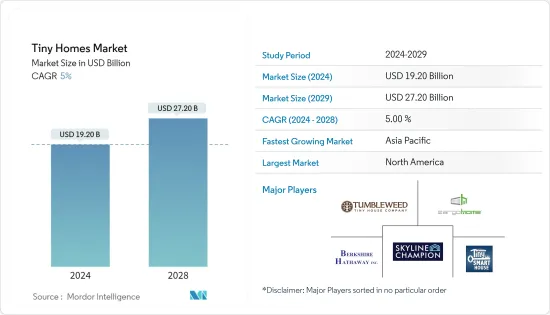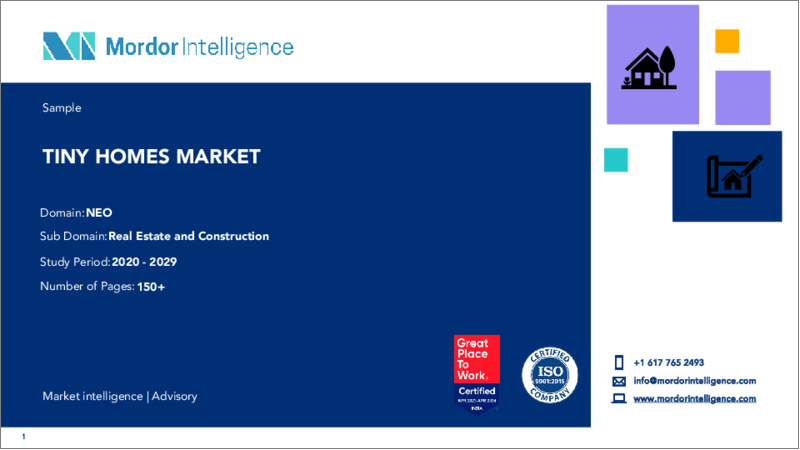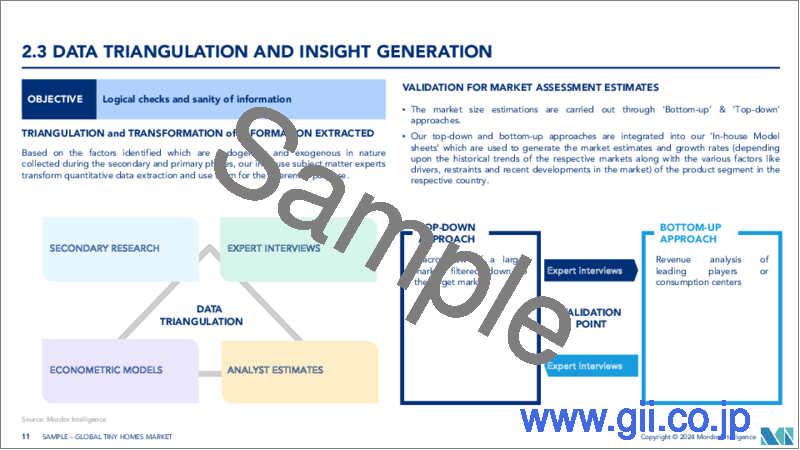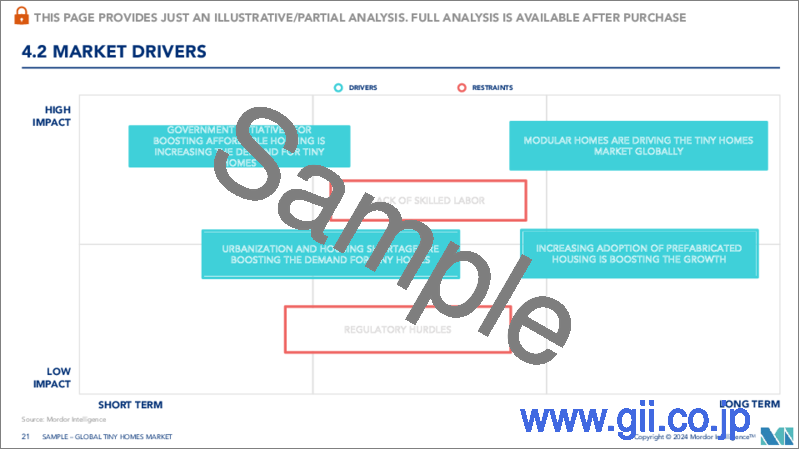|
|
市場調査レポート
商品コード
1521507
タイニーホーム:市場シェア分析、産業動向と統計、成長予測(2024年~2029年)Tiny Homes - Market Share Analysis, Industry Trends & Statistics, Growth Forecasts (2024 - 2029) |
||||||
カスタマイズ可能
適宜更新あり
|
|||||||
| タイニーホーム:市場シェア分析、産業動向と統計、成長予測(2024年~2029年) |
|
出版日: 2024年07月15日
発行: Mordor Intelligence
ページ情報: 英文 150 Pages
納期: 2~3営業日
|
全表示
- 概要
- 目次
タイニーホームの市場規模は2024年に192億米ドルと推定され、2029年には272億米ドルに達すると予測され、予測期間中(2024~2029年)のCAGRは5%で成長すると予測されます。

従来型の新築住宅の高コスト、サステイナブルライフスタイルの魅力、手頃な価格の住宅システムに対するニーズの高まりなどが、市場拡大の要因となっています。
市場を牽引しているのは、主に新築住宅の建設コストの高さと、プレビルド住宅やカスタマイズ住宅を簡単にレンタルできることです。タイニーハウスは、土地や建材などの資源が少なくて済むため、従来の住宅よりも費用対効果が高く、特に住宅コストが高い地域で、手頃な価格の住宅ソリューションを求める個人や家族にとって魅力的です。タイニーハウスに投資する家族も多いです。ダラス連邦準備銀行によると、賃貸料の前年比インフレ率は2022年6月の約5.8%から2023年5月には約8.4%に上昇すると予想されています。
予測期間を通じて、住宅のマス・カスタマイゼーションやパーソナライゼーションに対する顧客ニーズの高まりが市場を牽引すると予想されます。カスタマイズや想像力豊かなデザインは、小さな住宅でも可能です。特定のニーズや嗜好に合わせることで、個性的で独特な居住空間を作り出すことができます。これは、人々が自分のライフスタイルや個性に合った家を設計するのに役立ちます。
Skyline Champion CorporationやCMH Services Inc.のようなトップベンダーの存在が、この地域の市場成長を牽引しています。例えば、2022年7月、Alta Cima Corp.とSkyline Champion Corporationの関連会社であるChampion Retail Housingが契約を結びました。この契約では、Factory Expo Home Centresの資産買収と、米国内12カ所のSkyline Championの生産施設に入居していた事業の管理が行われました。従って、予測期間を通じて、北米の市場拡大は同地域の著名なサプライヤーの存在によって牽引されることになります。
タイニーホームの市場動向
手頃な価格の住宅需要の増加により、世帯向けセグメントが大きなシェアを占めると予測
米国では、新築住宅の中央価格は30万米ドル以上です。これは、頭金を貯めるのに苦労している多くの人々、特にミレニアル世代には手が届かないです。一方、タイニーホームは2万米ドルから購入できます。そのため、住む場所を探しているが資金に余裕がない人にとっては、手頃な選択肢となります。
米国では連邦政府レベルで、住宅に関するイニシアチブは住宅都市開発省(HUD)が主導しています。これは、建築や住宅ローンのプログラムを含むすべてをカバーしています。HUDのいくつかのイニシアチブの目標は、手頃な価格の住宅を増やすことです。セルフヘルプ・ホームオーナーシップ・オポチュニティ・プログラム(SHOP)もそのひとつです。NGOが低所得者向けに手頃な価格の住宅を建設するのを支援するため、SHOPプログラムは資金を記載しています。2023年7月と9月のデータによると、2011会計年度から2020会計年度の間に、SHOP補助金は40以上の州と140以上の都市圏で住宅建設を支援しました。
米国全土で住宅費が上昇を続ける中、固定収入のある高齢者は経済的負担を感じています。1,500万人以上の高齢者が連邦貧困水準の200%以下で生活していることから、高齢者向けの手頃で利用しやすい住宅への需要はかつてないほど高まっています。この増大する懸念に対処するため、高齢者向けの手頃な価格の住宅オプションと補助金に関する貴重な洞察をいくつか紹介しよう。
2030年までに、インドの不動産市場は1兆米ドルに達すると予測されており、手頃な価格の住宅はこの拡大に大きく貢献しています。人口のかなりの部分の購買力が低いこと、年平均人口増加率が2.1%であることから、一時は4,000万戸の都市型住宅のニーズを満たすことは不可能に見えました。しかしここ数年、政府は手頃な価格の住宅を支援するための重要な発表(数例)を行い、状況は変わってきています。
北米が市場の大きなシェアを占めると予想される
伝統的な住宅用フラットの高コスト、国際的な大手競合企業の存在、米国とカナダにおけるミレニアル世代からのカスタマイズ住宅に対する需要の高まりが、地域産業の台頭の要因となっています。カナダでは、現在から2027年の間に400万人以上の若いカナダ人が住宅購入を検討している可能性があり、26歳から41歳のミレニアル世代の60%が、不動産価格の高騰にもかかわらず、賃貸市場や親の家の地下室からの脱出を目指しています。
ある調査によると、まだ家を所有していないカナダのミレニアル世代のほぼ3分の2は、家を所有する自信があるが、そのうちの63%は、そのためには転居しなければならないと考えています。米国では、ミレニアル世代は住宅購入者の最大世代であり、今後何年にもわたって住宅動向と需要を牽引していく。また、彼らはオンラインで住宅を購入することに抵抗がなく、40%近くが最大の金融資産をオンラインで購入することに抵抗がないと回答しています。
さらに北米では、高級住宅購入者の大半はミレニアル世代であり、ピーク時の高級住宅購入者の59%は、300万米ドル以上の価格帯の住宅購入を検討しているミレニアル世代です。
例えば、2022年7月11日、Alta Cima CorporationとSkyline Championの関連会社であるChampion Retail Housingは、米国内のスカイライン・チャンピオンの12の生産工場に位置するファクトリー・エキスポ・ホームセンターの購入契約を締結しました。Skyline ChampionはAlta Cima Corporationからホームセンターの継続的な支援を受けています。
タイニーホーム業界概要
タイニーホーム市場は競争が激しく、細分化されており、多くの参入企業が存在します。大手、中堅、中小企業を含むあらゆる種類の企業が、タイニーホーム業界を支配しようと争っています。顧客ベースを増やし市場シェアを拡大するために、これらの企業の一部は、製品の発売、提携・協力、M&A、生産能力の増強など、いくつかの市場開拓戦術を採用しています。
市場の主要企業は、Skyline Champion Corporation、Tumbleweed Tiny House Company、Tiny SMART House, Inc.、Berkshire Hathaway Inc.などです。
その他の特典
- エクセル形式の市場予測(ME)シート
- 3ヶ月間のアナリストサポート
目次
第1章 イントロダクション
- 調査の成果
- 調査の前提
- 調査範囲
第2章 調査手法
第3章 エグゼクティブ概要
第4章 市場力学
- 市場概要
- 市場促進要因
- 市場抑制要因
- バリューチェーン/サプライチェーン分析
- 政府の規制と取り組み
- ポーターのファイブフォース分析
- 新規参入業者の脅威
- 買い手/消費者の交渉力
- 供給企業の交渉力
- 代替品の脅威
- 競争企業間の敵対関係の強さ
- COVID-19が市場に与える影響
第5章 市場セグメンテーション
- 製品タイプ別
- 移動型タイニーホーム
- 据え置き型タイニーホーム
- 面積別
- 130平方フィート以下
- 130~500平方フィート
- 500平方フィート以上
- 用途別
- 家庭用
- 商業用
- 産業用
- その他
- 地域
- 北米
- 欧州
- アジア太平洋
- 南米
- 中東
第6章 競合情勢
- 市場集中度概要
- 企業プロファイル
- Skyline Champion Corporation
- CargoHome
- Tiny SMART House, Inc.
- Tumbleweed Tiny House Company
- Berkshire Hathaway Inc.
- Aussie Tiny Houses
- Mustard Seed Tiny Homes LLC
- Mini Mansions Tiny Home Builders LLC
- Cavco Industries, Inc.
- Nestron*
第7章 市場機会と今後の動向
第8章 付録
The Tiny Homes Market size is estimated at USD 19.20 billion in 2024, and is expected to reach USD 27.20 billion by 2029, growing at a CAGR of 5% during the forecast period (2024-2029).

The high cost of brand-new conventional homes, the appeal of sustainable lifestyles, and the growing need for an affordable housing system are all factors contributing to the market's expansion.
The market is primarily driven by the high cost of building new homes and the ease with which pre-built or customized homes can be rented. Tiny houses are more cost-effective than traditional homes because they require less land, building materials, and other resources, which makes them appealing to individuals or families seeking affordable housing solutions, particularly in areas where housing costs are high. Many families have made investments in tiny houses because they are significantly less. According to the Federal Reserve Bank of Dallas, year-over-year rental inflation is expected to increase from around 5.8% in June 2022 to around 8.4% in May 2023.
Throughout the projection period, it is anticipated that growing customer demands for mass customization and personalization of their homes will drive the market. Customization and imaginative design are possible in little homes. They enable the creation of distinctive and individual living spaces by being tailored to specific needs and tastes. This can assist people in designing a house that suits their lifestyle and personality.
The presence of top vendors like Skyline Champion Corp. and CMH Services Inc. is driving the growth of the market in the area. For example, in July 2022, Alta Cima Corp. and Champion Retail Housing, a Skyline Champion affiliate, signed a contract. The deal called for the purchase of the Factory Expo Home Centres' assets and management of its operations, which were housed in 12 Skyline Champion production facilities around the US. Therefore, throughout the projected period, the market expansion in North America will be driven by the presence of prominent suppliers in the region.
Tiny Homes Market Trends
Household Segment Anticipated to Hold Major Share Due to Increasing Demand for Affordable Housing
In the United States, the median price of a new home is over USD 300,000. This is out of reach for many people, especially millennials, who are struggling to save for a down payment. Tiny homes, on the other hand, can be purchased for as little as USD 20,000. This makes them an affordable option for people looking for a place to live but need more money.
In the USA, At the federal level, housing initiatives are spearheaded by the Department of Housing and Urban Development (HUD). This covers everything, including building and mortgage programs. The goal of several HUD initiatives is to boost the availability of affordable housing. The Self-Help Homeownership Opportunity Programme (SHOP) is one of these. To assist NGOs in creating affordable housing for low-income buyers, the SHOP program awards funding. Between fiscal years 2011 and 2020, SHOP grants aided in the construction of homes in more than 40 states and 140 metropolitan regions, according to data from July and September 2023.
As housing costs continue to rise across the United States, older adults on fixed incomes are feeling the financial strain. The demand for affordable and accessible housing for senior citizens is greater than ever, as more than 15 million older adults find themselves living at or below 200 percent of the federal poverty level. To address this growing concern, here are some valuable insights into affordable housing options and subsidies for older adults.
By 2030, the Indian real estate market is predicted to reach USD 1 trillion, with affordable housing being a major contributor to this expansion. At one point, meeting the need for 40 million urban housing units looked unattainable due to the low purchasing power of a considerable portion of our population and an average annual population growth rate of 2.1%. But in the last few years, the government has made some significant announcements (a few examples) to support affordable housing, and things have changed.
North America is Anticipated to Hold a Major Share of the Market
The high cost of traditional residential flats, the presence of major international competitors, and the growing demand from millennials in the US and Canada for customized houses are the factors contributing to the rise of the regional industry. In Canada, more than four million young Canadians could be looking to buy a home between now and 2027, and 60% of millennials aged 26 to 41 aim to get out of the rental market or their parent's basement despite high real estate prices.
A survey found that almost two-thirds of Canadian millennials who don't already own a home are confident they will own a home, but 63% of them believe they will have to relocate to achieve this. In the US, millennials represent the largest generation of home buyers and are driving housing trends and demand for years to come. They are also comfortable buying homes online, with nearly 40% saying they would be comfortable purchasing their biggest financial asset online.
Additionally, in North America, the majority of luxury homebuyers are millennials, with 59% of peak luxury buyers being millennials who are looking to buy homes above the USD 3M price point.
For example, on July 11, 2022, Alta Cima Corporation and Champion Retail Housing, a Skyline Champion affiliate, signed into an agreement for the purchase of the Factory Expo Home Centre, which is situated at 12 Skyline Champion production plants across the United States. Skyline Champion receives continuous assistance from Alta Cima for the home centers.
Tiny Homes Industry Overview
The tiny homes market is highly competitive and fragmented, with the presence of many players. Businesses of all kinds, including major, medium, and small-sized enterprises, are fighting to dominate the tiny homes industry. To increase their customer base and increase their market share, some of these firms have embraced several business development tactics, such as product launches, partnerships and collaborations, mergers and acquisitions, and increasing production capacity.
Major Players in the market are Skyline Champion Corporation, Tumbleweed Tiny House Company, Tiny SMART House, Inc., and Berkshire Hathaway Inc.
Additional Benefits:
- The market estimate (ME) sheet in Excel format
- 3 months of analyst support
TABLE OF CONTENTS
1 INTRODUCTION
- 1.1 Study Deliverables
- 1.2 Study Assumptions
- 1.3 Scope of the Study
2 RESEARCH METHODOLOGY
3 EXECUTIVE SUMMARY
4 MARKET DYNAMICS
- 4.1 Market Overview
- 4.2 Market Drivers
- 4.3 Market Restraints
- 4.4 Value Chain / Supply Chain Analysis
- 4.5 Government Regulations and Initiatives
- 4.6 Porter's Five Forces Analysis
- 4.6.1 Threat of New Entrants
- 4.6.2 Bargaining Power of Buyers/Consumers
- 4.6.3 Bargaining Power of Suppliers
- 4.6.4 Threat of Substitute Products
- 4.6.5 Intensity of Competitive Rivalry
- 4.7 Impact of COVID-19 on the Market
5 MARKET SEGMENTATION
- 5.1 By Product Type
- 5.1.1 Mobile Tiny Homes
- 5.1.2 Stationary Tiny Homes
- 5.2 By Area
- 5.2.1 Less Than 130 Sq. Ft.
- 5.2.2 130-500 Sq. Ft.
- 5.2.3 More Than 500 Sq. Ft.
- 5.3 By Application
- 5.3.1 Household
- 5.3.2 Commercial
- 5.3.3 Industrial
- 5.3.4 Others
- 5.4 Geography
- 5.4.1 North America
- 5.4.2 Europe
- 5.4.3 Asia Pacific
- 5.4.4 South America
- 5.4.5 Middle East
6 COMPETITIVE LANDSCAPE
- 6.1 Market Concentration Overview
- 6.2 Company Profiles
- 6.2.1 Skyline Champion Corporation
- 6.2.2 CargoHome
- 6.2.3 Tiny SMART House, Inc.
- 6.2.4 Tumbleweed Tiny House Company
- 6.2.5 Berkshire Hathaway Inc.
- 6.2.6 Aussie Tiny Houses
- 6.2.7 Mustard Seed Tiny Homes LLC
- 6.2.8 Mini Mansions Tiny Home Builders LLC
- 6.2.9 Cavco Industries, Inc.
- 6.2.10 Nestron*





